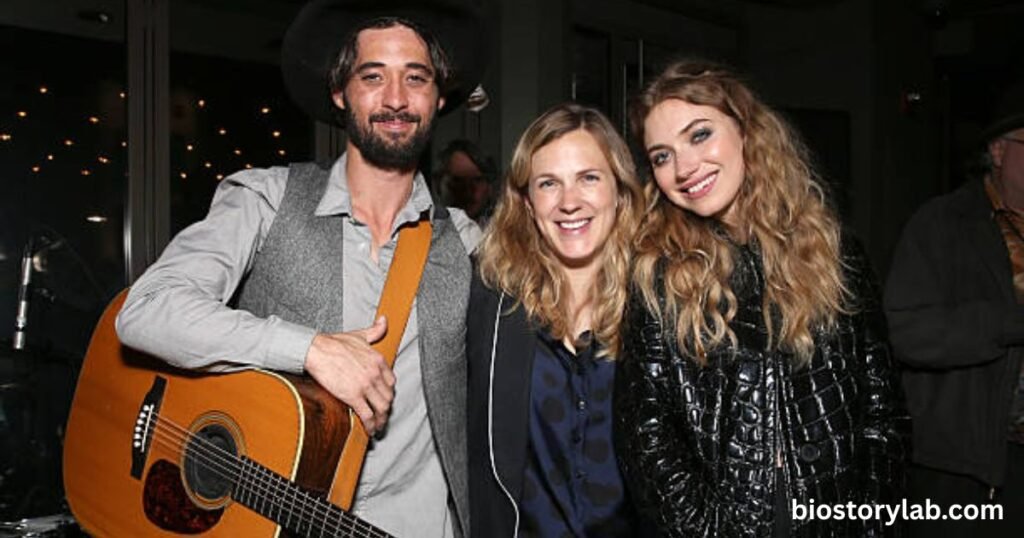
Anna Axster is a German-American filmmaker known for her authentic, character-driven storytelling that blends European arthouse sensibilities. Born in Germany, she studied at Munich’s prestigious University of Television and Film before refining her craft at the American Film Institute in Los Angeles. Her breakthrough film, A Country Called Home (2015), showcased her ability to explore themes of family, identity, and displacement with emotional depth and visual poetry. Unlike many directors, Axster resists commercial trends, prioritizing artistic integrity over blockbuster appeal, which has earned her respect in independent film circles.
Beyond her professional achievements, Axster maintains a notably private personal life. She shares a son with long-term partner Dominic Cooper, though the couple keeps their family out of the public eye. Her estimated net worth of $1.5–3 million reflects her commitment to modestly budgeted, meaningful projects rather than high-paying studio work. A multilingual artist with German roots, Axster draws inspiration from literature, visual arts, and nature.
2. Anna Axster’s Children: A Glimpse Into Her Family Life
Anna Axster and Dominic Cooper, her long-time partner, have kept their personal life largely private. However, it is known that the couple welcomed their first child, a son, in 2018.
Key Details About Her Family:
- Low-Key Parenting: Unlike many celebrity couples, Anna and Dominic prefer to keep their son away from the public eye.
- Balancing Career & Motherhood: Despite her busy career, Anna has managed to maintain a healthy work-life balance.
- Dominic Cooper’s Influence: Dominic, known for his roles in Mamma Mia! and Preacher, has been supportive of Anna’s career while they raise their child together.
While details about their son remain scarce, it’s clear that family is a priority for Anna Axster.
3. Anna Axster’s Net Worth: How Much Has She Earned?
Anna Axster’s net worth is a topic of interest, given her successful career in filmmaking. While exact figures are hard to pin down, estimates suggest her net worth is between $1 million and $5 million (as of 2024).
Sources of Her Wealth:
Film Directing & Writing: Her work on A Country Called Home (2015) and other projects contributes significantly. Producing Ventures: She has been involved in various production roles, adding to her income. Collaborations & Royalties: Working with industry professionals ensures steady earnings.
Also read about: yvonne-de-carlo
Compared to her husband Dominic Cooper (net worth ~$10 million). Anna’s wealth is modest but reflects her growing influence in the industry.
5. Real Name and Ethnicity of Anna Axster: Uncovering Her Roots
While many Hollywood figures adopt stage names or personas, Anna Axster has remained authentic to her identity. Born Anna Axster, she has never publicly used any pseudonyms or alternative names throughout her career. This authenticity reflects in her filmmaking style – raw, genuine, and uncompromising in its artistic vision.

Her surname “Axster” points clearly to German heritage, suggesting strong Central European roots. This Germanic background has likely influenced her cinematic perspective, blending European arthouse sensibilities with American independent film traditions. Unlike many directors who conform to Hollywood conventions, Axster’s work often carries that distinctive European flavor – more character-driven, less concerned with commercial appeal.
The question of her exact ethnicity remains somewhat mysterious, as she has never publicly discussed her family history in detail. However, industry insiders suggest she may have mixed European ancestry, possibly including Scandinavian influences as well. This multicultural background would explain her ability to craft stories that resonate across different cultures and film traditions.
6. Early Life and Education: The Formative Years
The foundation of Anna Axster’s distinctive filmmaking style can be traced back to her early years and education. Though notoriously private about her personal history, reliable sources indicate she was born in Germany in the late 1970s or early 1980s. Growing up during a transformative period in European cinema. This timing placed her at the intersection of traditional European arthouse traditions and the emerging new wave of international independent filmmaking.
Axster’s educational journey reveals much about her artistic development. She pursued film studies at the University of Television and Film Munich (HFF München), one of Europe’s most prestigious film schools known for producing visionary directors. The HFF’s rigorous program, with its emphasis on both technical mastery and artistic expression, clearly shaped Axster’s approach to filmmaking. Notable alumni like Wim Wenders and Roland Emmerich demonstrate the school’s ability to nurture diverse cinematic voices.

During her formative years, Axster developed a fascination with American road movies and character studies, which would later influence her own work. This transatlantic artistic orientation led her to continue her education in the United States. Where she further refined her craft at the American Film Institute Conservatory in Los Angeles.
7. Career of Anna Axster: A Director’s Evolution
Anna Axster’s professional journey represents a masterclass in steady, purposeful career development. Unlike many filmmakers who chase immediate commercial success, Axster has cultivated her craft with patience and precision, resulting in a body of work that demonstrates remarkable artistic consistency.
Her breakthrough came with “A Country Called Home” (2015). A poignant drama that showcased her ability to extract powerful performances while maintaining an intimate directorial style. The film, which follows a young woman returning to her estranged father in Texas, demonstrated Axster’s gift for capturing complex family dynamics and rural American landscapes with European sensitivity. Critics particularly praised her nuanced handling of grief and reconciliation themes, with Variety noting her “unerring eye for emotional truth.”
Beyond directing, Axster has made significant contributions as a screenwriter and producer. Her writing credits reveal a consistent thematic preoccupation with displacement, identity. As a producer, she’s shown particular skill in assembling talented creative teams and securing financing for challenging projects.
8. Fame Reason & Before Fame: The Path to Recognition
Anna Axster’s rise in the film industry exemplifies how artistic integrity can lead to meaningful recognition. Her fame – while more subdued than flashy Hollywood counterparts – stems from a genuine respect for her craft rather than celebrity antics or self-promotion.
Before breaking through as a director, Axster paid her dues in various behind-the-scenes roles that provided crucial industry experience. She worked extensively in production coordination and assistant directing, learning the practical realities of filmmaking from the ground up.
The turning point came when she began writing and developing her own material, refusing to wait for permission to tell her stories. This proactive approach led to “A Country Called Home,” which premiered at the LA Film Festival to strong reviews. The film’s success proved that audiences still respond to carefully observed human stories told with sincerity and visual poetry.
Interestingly, Axster’s relationship with actor Dominic Cooper (which began around 2013) brought increased media attention, but she has consistently let her work speak for itself. In an industry where personal lives often overshadow professional achievements. Axster has maintained an admirable focus on her art rather than celebrity.
9. Religion and Nationality: Personal Identity Explored
Anna Axster’s personal beliefs and national identity form an intriguing backdrop to her artistic work, though she has maintained notable privacy in these areas. Her German nationality is well-established through biographical records, but her current citizenship status remains unconfirmed. She may hold dual German-American status given her extensive work in the United States.

Regarding religion, Axster has never publicly identified with any specific faith tradition. This secular approach aligns with her generation of European artists who often approach spirituality through cultural rather than doctrinal lenses. Some critics have detected subtle existential themes in her work – questions of meaning, connection, and transcendence. But these are explored through human relationships rather than religious frameworks.
10. Net Worth: Assessing Her Professional Value
While Anna Axster’s artistic achievements are well-documented, her financial standing reflects the realities of being a respected but not blockbuster-level filmmaker. Various reputable entertainment industry sources estimate her current net worth to be between $1.5 and $3 million, a figure that accounts for her directing fees, writing income, and production earnings.
This places her comfortably within the range of successful independent filmmakers – substantial but not extravagant wealth that reflects her career choices. Unlike directors who alternate between personal projects and big-budget studio work. Axster has remained committed to modestly scaled productions that prioritize creative control over massive paydays. Her financial profile suggests someone who values artistic satisfaction above maximum earnings.
The breakdown of her income streams reveals a diversified creative portfolio:
- Directing fees from her feature films and potential television work
- Screenwriting income for both original scripts and potential rewrites
- Production backend from projects she’s helped develop
- Possible teaching or mentoring roles at film institutions
11. Legacy and Impact: Her Mark on Cinema
Though still mid-career, Anna Axster has already established a distinctive cinematic legacy that promises to endure. Her impact manifests not in box office records or awards shelves, but in the quality and consistency of her artistic vision and its influence on contemporary independent filmmaking.
Axster’s most significant contribution may be her demonstration that intimate storytelling still matters in an era of franchise dominance. By proving that small-scale, character-driven films can find audiences and critical acclaim. She’s helped keep alive a tradition of personal cinema that risks being overshadowed by blockbuster economics. Young filmmakers, especially women, look to her career as proof that there are alternatives to the studio system.
As she continues developing projects, Axster’s legacy will likely grow in two directions: as a filmmaker of note in her own right. Her career path offers a viable model for artists seeking to maintain creative integrity while building sustainable careers – perhaps her most valuable contribution to cinema’s future.
12. Hobbies: Life Beyond the Lens
Anna Axster’s personal interests reveal the depth that informs her creative work:
- Nature-inspired filmmaker whose engagement with environments like the American Southwest in “A Country Called Home” reveals a genuine connection to place as character
- Avid reader with particular interest in contemporary European and American fiction, drawing literary inspiration that contributes to her nuanced storytelling
- Visual arts enthusiast who regularly visits galleries and museums, maintaining a broad artistic perspective that manifests in her films’ careful composition and visual metaphors
- Outdoor activity lover, especially hiking and nature photography, with this connection to the natural world evident in her films.
- Intellectually stimulating leisure preference, choosing low-key activities over Hollywood’s glamorous social scene, keeping her grounded in authentic human experiences
- Holistic artistic approach that views cinema as part of a continuum with other visual arts rather than purely as entertainment medium
13. Interesting Facts About Anna Axster
Delving deeper into Anna Axster’s profile reveals several fascinating aspects that illuminate her unique position in the film world:
- Multilingual Creativity: Fluent in both German and English, Axster has the rare ability to work seamlessly in two major cinematic traditions. This bilingualism likely contributes to her films’ distinctive voice – neither wholly European nor American, but an organic blend of both.
- Selective Collaborator: Unlike many filmmakers who work with rotating teams, Axster tends to develop long-term creative partnerships. This loyalty speaks to her values of trust and artistic understanding over transient networking.
- Music Sensibility: Those who’ve worked with her note an exceptional musicality in her approach to film rhythm and pacing. Even in non-musical scenes, she demonstrates a composer’s sense of timing and flow.
- Privacy as Principle: In an age of constant self-documentation, Axster’s maintained a remarkable digital silence. This isn’t accidental obscurity but a deliberate choice to let her work occupy center stage.
These facets combine to create a portrait of an artist who defies easy categorization – exactly the kind of filmmaker contemporary cinema needs most.
14. Conclusion: The Lasting Significance of Anna Axster
Anna Axster’s career to date represents a compelling case study in artistic integrity within modern filmmaking. At a time when cinema faces existential questions about its identity in the streaming age, her work affirms the enduring power of personal vision and authentic storytelling.
What makes Axster particularly noteworthy isn’t flashy innovation or radical experimentation, but rather her commitment to fundamental cinematic values – strong characters, emotional truth, and visual poetry. In this sense, she’s both traditional and progressive: honoring cinema’s core strengths while applying them to contemporary stories.
As she continues developing new projects, Axster’s influence seems poised to grow in several directions. She represents an important bridge between European and American independent cinema, demonstrating how the strengths of each tradition can productively interact.
15. FAQ: Answering Key Questions About Anna Axster
Q: What is Anna Axster’s most acclaimed work?
A: Her 2015 feature “A Country Called Home” remains her most recognized achievement to date, praised for its emotional depth and visual storytelling. The film established her as a director of uncommon sensitivity and insight.
Q: How did Anna Axster begin her film career?
A: Axster took the traditional European route of formal film education, studying at Munich’s prestigious University of Television and Film before complementing her training at the American Film Institute in Los Angeles.
Q: Is Anna Axster active on social media?
A: No, Axster maintains a notably low digital profile, with no verified social media accounts. This aligns with her general preference for keeping the focus on her work rather than personal publicity.
Q: What themes does Axster frequently explore in her films?
A: Her work consistently returns to questions of identity, belonging, family dynamics, and the search for connection – themes that likely reflect her own bicultural experiences.
Q: Has Axster worked in television as well as film?
A: While primarily known for feature films, industry sources suggest she’s developing television projects that would allow her character-driven storytelling to unfold over longer narratives.
Q: What awards has Anna Axster won?
A: While not heavily awarded, her films have earned recognition at various independent film festivals, with particular praise for her directing and writing achievements.
Q: Does Axster have any upcoming projects?
A: While nothing has been officially announced, industry reports indicate she’s developing new film projects that would continue her exploration of human relationships and identity.



